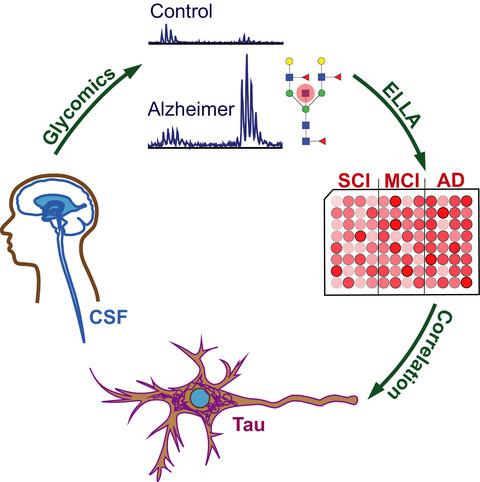Our official English website, www.x-mol.net, welcomes your
feedback! (Note: you will need to create a separate account there.)
Glycan biomarkers for Alzheimer disease correlate with T-tau and P-tau in cerebrospinal fluid in subjective cognitive impairment.
The FEBS Journal ( IF 5.5 ) Pub Date : 2019-12-30 , DOI: 10.1111/febs.15197 Sophia Schedin-Weiss 1 , Stefan Gaunitz 1 , Ping Sui 1 , Qiushi Chen 2 , Stuart M Haslam 2 , Kaj Blennow 3, 4 , Bengt Winblad 1 , Anne Dell 2 , Lars O Tjernberg 1
The FEBS Journal ( IF 5.5 ) Pub Date : 2019-12-30 , DOI: 10.1111/febs.15197 Sophia Schedin-Weiss 1 , Stefan Gaunitz 1 , Ping Sui 1 , Qiushi Chen 2 , Stuart M Haslam 2 , Kaj Blennow 3, 4 , Bengt Winblad 1 , Anne Dell 2 , Lars O Tjernberg 1
Affiliation

|
Alzheimer disease (AD) is a devastating disease and a global health problem, and current treatments are only symptomatic. A wealth of clinical studies support that the disease starts to develop decades before the first symptoms appear, emphasizing the importance of studying early changes for improving early diagnosis and guiding toward novel treatment strategies. Protein glycosylation is altered in AD but it remains to be clarified why these alterations occur and how they affect the disease development. Here, we used a glycomics approach to search for alterations in protein glycosylation in cerebrospinal fluid (CSF) in AD compared with nondemented controls. Using both matrix‐assisted laser desorption ionization‐time of flight and liquid chromatography–electrospray mass spectrometry, we observed an increase in N‐glycans carrying bisecting N‐acetylglucosamine in AD. Based on those findings, we designed an enzyme‐linked multiwell plate assay to quantify N‐glycans binding to the lectin Phaseolus vulgaris Erythroagglutinin (PHA‐E), which is specific for N‐glycans containing bisecting N‐acetylglucosamine. Using this assay, we found a similar increase in CSF in AD compared with controls. Further analysis of CSF from 242 patients with subjective cognitive impairment (SCI), mild cognitive impairment (MCI), or AD dementia revealed significantly increased binding to PHA‐E in MCI and AD compared to SCI. Interestingly, PHA‐E binding correlated with CSF levels of phosphorylated tau and total tau and this correlation was most prominent in the SCI group (R = 0.53–0.54). This study supports a link between N‐glycosylation, neurodegeneration, and tau pathology in AD and suggests that glycan biomarkers have potential to identify SCI cases at risk of developing AD.
中文翻译:

阿尔茨海默病的聚糖生物标志物与主观认知障碍中脑脊液中的 T-tau 和 P-tau 相关。
阿尔茨海默病 (AD) 是一种毁灭性疾病和全球健康问题,目前的治疗只是对症治疗。大量临床研究支持该疾病在第一个症状出现前几十年就开始发展,这强调了研究早期变化以改善早期诊断和指导新治疗策略的重要性。AD 中的蛋白质糖基化发生了改变,但这些改变发生的原因以及它们如何影响疾病发展仍有待澄清。在这里,我们使用糖组学方法来搜索与非痴呆对照相比,AD 脑脊液 (CSF) 中蛋白质糖基化的变化。使用基质辅助激光解吸电离飞行时间和液相色谱-电喷雾质谱,我们观察到在 AD 中携带平分 N-乙酰氨基葡萄糖的 N-聚糖增加。基于这些发现,我们设计了一种酶联多孔板测定法来量化 N-聚糖与凝集素的结合菜豆红血球凝集素 (PHA-E),特异于含有二等分 N-乙酰氨基葡萄糖的 N-聚糖。使用该测定,我们发现与对照相比,AD 中的 CSF 有类似的增加。对 242 名主观认知障碍 (SCI)、轻度认知障碍 (MCI) 或 AD 痴呆患者的 CSF 的进一步分析显示,与 SCI 相比,MCI 和 AD 中与 PHA-E 的结合显着增加。有趣的是,PHA-E 结合与磷酸化 tau 和总 tau 的 CSF 水平相关,这种相关性在 SCI 组中最为突出(R = 0.53-0.54)。该研究支持 AD 中 N-糖基化、神经变性和 tau 病理之间的联系,并表明聚糖生物标志物有可能识别有发展为 AD 风险的 SCI 病例。
更新日期:2019-12-30
中文翻译:

阿尔茨海默病的聚糖生物标志物与主观认知障碍中脑脊液中的 T-tau 和 P-tau 相关。
阿尔茨海默病 (AD) 是一种毁灭性疾病和全球健康问题,目前的治疗只是对症治疗。大量临床研究支持该疾病在第一个症状出现前几十年就开始发展,这强调了研究早期变化以改善早期诊断和指导新治疗策略的重要性。AD 中的蛋白质糖基化发生了改变,但这些改变发生的原因以及它们如何影响疾病发展仍有待澄清。在这里,我们使用糖组学方法来搜索与非痴呆对照相比,AD 脑脊液 (CSF) 中蛋白质糖基化的变化。使用基质辅助激光解吸电离飞行时间和液相色谱-电喷雾质谱,我们观察到在 AD 中携带平分 N-乙酰氨基葡萄糖的 N-聚糖增加。基于这些发现,我们设计了一种酶联多孔板测定法来量化 N-聚糖与凝集素的结合菜豆红血球凝集素 (PHA-E),特异于含有二等分 N-乙酰氨基葡萄糖的 N-聚糖。使用该测定,我们发现与对照相比,AD 中的 CSF 有类似的增加。对 242 名主观认知障碍 (SCI)、轻度认知障碍 (MCI) 或 AD 痴呆患者的 CSF 的进一步分析显示,与 SCI 相比,MCI 和 AD 中与 PHA-E 的结合显着增加。有趣的是,PHA-E 结合与磷酸化 tau 和总 tau 的 CSF 水平相关,这种相关性在 SCI 组中最为突出(R = 0.53-0.54)。该研究支持 AD 中 N-糖基化、神经变性和 tau 病理之间的联系,并表明聚糖生物标志物有可能识别有发展为 AD 风险的 SCI 病例。











































 京公网安备 11010802027423号
京公网安备 11010802027423号